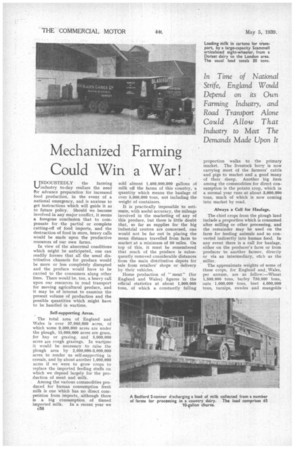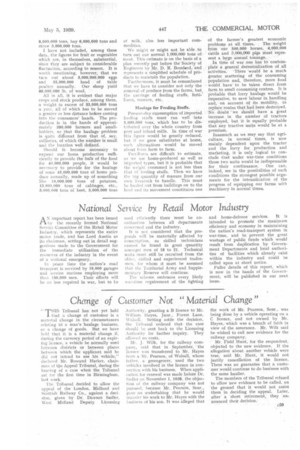Mechanized Farming Could Win a War!
Page 108

Page 109

If you've noticed an error in this article please click here to report it so we can fix it.
UNDOUBTEDLY the farming industry to-day realizes the need feu. advance preparation for increased food production, in the event of a national emergency, and is anxious to get instructions which will guide it as to future policy. Should we become involved in any major conflict, it seems a foregone conclusion that to compensate for the partial or complete cutting-off of food imports, and the destruction of food in store, heavy calls would be made upon the productive resources of our own farms.
In view of the abnormal conditions which might be anticipated, one can readily foresee that all the usual distributive channels for produce would be more or less completely disrupted and the produce would have to be carried to the consumers along other lines. There would be, too, a heavy call upon our resources in road transport for moving agricultural produce, and it may be of interest to examine the present volume of production and the possible quantities which might have to be handled in wartime.
Self-supporting Areas.
The total area of England and Wales is over 37,000,000 acres, of which some 9,000,000 acres are under the plough, 15,000,000 acres are grass, for hay or grazing, and 5,000,000 acres are rough gratings. In wartime it would be necessary to raise the plough area by 2,000,000-3,000,000 acres to render us self-supporting in cereals, and by about another 1,000,000 acres if we were to grow crops to replace the imported feeding stuffs on which we depend largely for the production of meat and milk.
Among the various commodities produced for human consumption fresh milk is one which has no direct competition from imports, although there is a big consumption of tinned imported milk. In a recent year we
c58 sold almost 1,400,000,000 gallons of milk off the farms of this country, a quantity which means the haulage of over 5,000,000 tons, not including the weight of containers.
It is practically impossible to estimate, with useful accuracy, the mileage involved in the marketing of any of this produce, but there is little doubt that, so far as supplies for the big industrial centres are concerned, one would not be far out in placing the mean distance travelled from farm to market at a minimum of 50 miles. On top of this, it must be remembered that much of the produce is subsequently removed considerable distances from the main distributive depots for sale from retailers' shops or delivery by their vehicles.
Home production of " meat " (for England and Wales) figures in the official statistics at about 1,000,000 tons, of which a constantly falling proportion walks to the primary market. The livestock lorry is now carrying most of the farmers' cattle and pigs to market and a good many of their sheep. Another big item among the commodities for direct consumption is the potato crop, which in a normal year runs at about 3,000,000 tons, much of which is now coming into market by road.
Always a Call for Haulage.
The chief crops from the plough land include a proportion which is consumed after milling or other processing, and the remainder may be used on the farm for feeding animals and so converted indirectly into human food. fa any event there is a call for haulage, either on the producer's farm or from producer to another farmer, directly or via an intermediary. sah as the miller.
The approximate weights of some of these crops, for England and, Wales, per annum, are as follow:—Wheat 1,500,000 tons, barley 750,000 tons, oats 1,000,000 tons, beet 4,000,000 tons, turnips, swedes and mangolds
8,000,000 tons, hay 6,000,000 tons and straw 3,000,000 tons.
I have not included, among these data, the figures for fruit or vegetables which are, in themselves, substantial, since they are subject to considerable fluctuation, according to season. It is worth mentioning, however, that we turn out about 3,000,000,000 eggs and 35,000,000 head of table poultry annually. Our sheep yield 80,000,000 lb. of wool_ All in all, it is evident that major crops and stock produce, among them, a weight in excess of 33,000,000 tons a year, all of which has to be moved a greater or less distance before coming into the consumers' hands. The production is in the hands of approximately 380,000 farmers and smallholders, so that the haulage problem is quite different from that of, say, collieries, of which the number is small and the location well defined.
Should itbecome necessary to expand our home production sufficiently to provide the bulk of the food for 40,000,000 people, it would be necessary to provide for the haulage of some 45,000,000 tons of home produce annually, made up of something like 19,000,000 tons of potatoes, 13,000,000 tons of cabbages, etc., 3,000,000 tons of beet, 5,000,000 tons
of milk, also less important commodities.
We might or might not be able to turn out our normal 1,000,000 tons of meat. This estimate is on the basis of a plan recently put before the Societyof Engineers by Mr. D, R. Bornford,. and represents a simplified schedule of products to maintain the population_
Furthermore, it must be remembered that we have to consider not only the removal of produce from the farms, but the carriage of feeding stuffs, fertilizers, manure, etc.
Haulage for Feeding Stuffs.
Present-day consumption of iMported feeding stuffs must run well into 5,000,000 tons, which has to be distributed over the whole country from port and inland mills. In time of war this figure would be greatly reduced, but if we grew substitutes at home, such alternatives would be moved about from farm to farm.
Fertilizers are difficult to estimate, as we use home-produced as well as imported types, but it is probable that the A, eight consumed is not less than that of feeding stuffs. Then we have the big quantity of manure from our own livestock to handle. This must be hauled out from buildings on to the land and its movement constitutes one of the farmer's greatest economic problems at all times. The weight from our 500,000 horses, 4,000,000 cattle and 3,000,000 pigs must represent a large annual tonnage. In time of war: one has to contemplate a general decentralization of all
activities. There would be a much greater scattering of the consuming population and, therefore, more food would have to be taken direct from farm to small consuming centres. It is probable that lorry haulage would be imperative, to save labour in handling and, on account of its mobility, to replace routes that had been destroyed. No doubt • we should have a great increase in the number of tractors employed, but it is equally probable that any tractive units would be at a premium. Inasmuch as we may say that agriculture, in normal times, is now mainly dependent upon the tractor and the lorry for production and marketing, it is only logical to conclude that under war-time conditions those two units would be indispensable for their continuance. One can, indeed, see in the possibilities of such conaitions the strongest possible arguments for the intensification of the progress of equipping our farms with machinery in normal times.
































































































































































